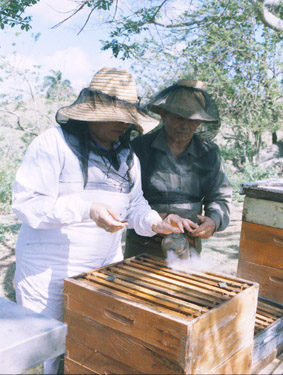|
QUEEN BEES EXPORTS TO THE EUROPEAN UNION
Giovanni Formato
gioformato@yahoo.es
- Instituto Zooprofilattico Sperimentale delle Regioni Lazzio y Toscana - Rome - Italy

With the Giovanni Formato's article published in Espacio Apícola 70th edition, about the 21 points of the Good Beekeeping Practices in Italy, we insinuated the possibility of bilateral agreements to facilitate the beekeeping trade between Argentina and Italy.
In this new article that the young technical from the "Instituto Zooprofilattico Sperimentale delle Regioni Lazio y Toscana" sends us, based on the experience of queen bees exports to Italy made at the beginning of 2006 by people from "Los Manantiales Co.", important alternatives are seen for the Argentinean beekeeping, in the middle of an European legislation submerged in a paralyzed bureaucracy.
Argentina has the advantage of producing bees of Apis mellifera ligustica race with high purity, demanded by the most professional beekeepers in the world and having Italy, cradle of this race, as entrance door to the market of queen bees in the north hemisphere, is an important opportunity.
In the article, Giovanni presents the requirements of "QUEEN BEES IMPORTS TO THE EUROPEAN UNION", the "EFFECTIVE REGULATION DURING THE INSPECTION", the "REQUIREMENT OF CERTIFIED", "THE SANITARY INFORMATION to CERTIFY" presenting finally an encouraging panorama for the Argentinean breeder in his "CONCLUSIONS AND SUGGESTIONS", with "Bibliography" and copies of the models of certificates and required documentation.
To top
ANTECEDENTS, EVOLUTION AND PERSPECTIVE OF THE BEEKEEPING IN THE "PAMPA HUMEDA"
- Patricio Crespo
patriciocrespo@yahoo.com
- Chivilcoy - Buenos Aires - Argentina
After some years rehearsing in a systematic way the complementation between the cattle and beekeeping activity, Patricio Crespo, offers us a wider vision that we believe it allows to go from the occasional reaction in front of the soya joint, toward a development and growth perspective.
The challenge is not small because, it responds to the necessities of hundred of families that, with a modest productive unit and generally complementary to another job, with between 100 and 250 beehives, they need to make more profitable that investment and effort.
In this article we will find important arguments that sustain the motto that we intended in San Francisco's Api-Expo: “For an Agricultural Integration”, very useful not only to start a dialogue with the owner of a field parcel, although as a contribution to an agricultural planning.
After the "INTRODUCTION" Patricio presents "THE SMALL-MEDIUM BEEKEEPER'S PROBLEM", "THE SOWING AS AN ALTERNATIVE", "THE CATTLE OUTLINE" and the "BEEKEEPING COUNTERPOINT" to finish with a detailed "ANALYSIS AND PERSPECTIVES."
To top
|

 ARGENTINE BEEKEEPING MAGAZINE
ARGENTINE BEEKEEPING MAGAZINE


 inform@apicultura.com.ar
inform@apicultura.com.ar